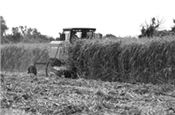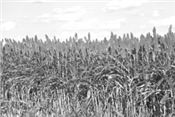|
Late Planting Of Sorghum For Hay Or Grazing
BRENT BEAN AND KIM MCCUISTION
LUBBOCK, TEXAS
Drought conditions over the last several months have left many regions short on hay or forage for grazing. However, growers still have time to plant forage sorghums to partially fill this need since only 60 days of growing season are required to produce a hay crop.
Several types of forage sorghums are available and versatile enough to fit many different cropping and livestock systems. These forage sorghums are considered drought tolerant yet respond well to favorable rainfall conditions. When managed properly, they can provide excellent hay or grazing and can be used in emergencies to replace failed crops due to drought, hail or other weather calamities at minimal costs. Forage sorghum also serves as an excellent cover crop, suppressing weeds and protecting the soil from wind and water erosion.
Although sorghum of any type can be used for hay or grazing, a sorghum-sudangrass cross or a sudangrass is usually a best choice. These varieties have smaller diameter stalks, which improve drydown for hay and palatability for cattle versus forage sorghums normally used for silage. They are sold as conventional, brown midrib (BMR), photoperiod sensitive (PS), and sterile varieties that do not produce grain.
The BMR varieties have less lignin, making them generally more digestible and higher quality than conventional varieties. As a trade-off for higher quality, these varieties can possess a greater tendency to lodge. If the sorghum is used for grazing, then lodging will not be an issue. In grazing trials, BMR varieties have shown to improve daily gain by as much as 0.75 pounds per day. The PS varieties have an advantage in total yield when planted early. However, this advantage decreases when planted later because day length becomes shorter.
Seeding rate varies depending on end use, planting method, row spacing and potential rainfall or irrigation. Typically, when planted with a drill, seeding rates range from 15 to 25 pounds of seed per acre. Nitrogen needs also vary, but normally 60 to 90 pounds applied prior to planting is sufficient. Growers should apply less nitrogen as the planting date is delayed and yield potential is decreased. Growers can visit with a seed company agronomist or extension forage specialist for seeding rates and other considerations for their region.
Sugarcane aphids also can become a greater problem in late-planted sorghum, making an insecticide seed treatment a good recommendation for 30 to 40 days of control.

Cattle should be allowed to graze sorghum once it has reached a height of 18 to 24 inches to prevent issues with nitrates or prussic acid. Research using BMR and PS sorghum-sudangrasses has produced average daily gains between 2 and 3 pounds per head per day over an 80-day grazing period. To take full advantage of a later planting date, higher stocking rates can be used over a shorter time frame. Typical stocking rates range between 1.5 and 2.5 stockers per acre. Gains per head and gains per acre vary greatly based on forage growth conditions, grazing management, cattle condition/weight and stocking rate.
For hay production, sorghum can be cut anytime after it has reached a height of 30 inches. Quality of the forage, particularly crude protein, will decrease as the sorghum matures. A good rule of thumb for producing both quality and tonnage of forage is to harvest sorghum at the boot stage, which is just prior to heading.
Though usually not an issue, growers should be aware of potential nitrate toxicity and prussic acid poisoning under drought conditions or when an early frost occurs late in the season. These issues are a greater concern when sorghum is grazed than when it is hayed. Prussic acid largely dissipates when hay is properly cured.
For more information on forage production, visit www.sorghumcheckoff.com. ∆
BRENT BEAN: USCP Director of Agronomy
KIM MCCUISTION: USCP Animal Nutrition Director


|
|